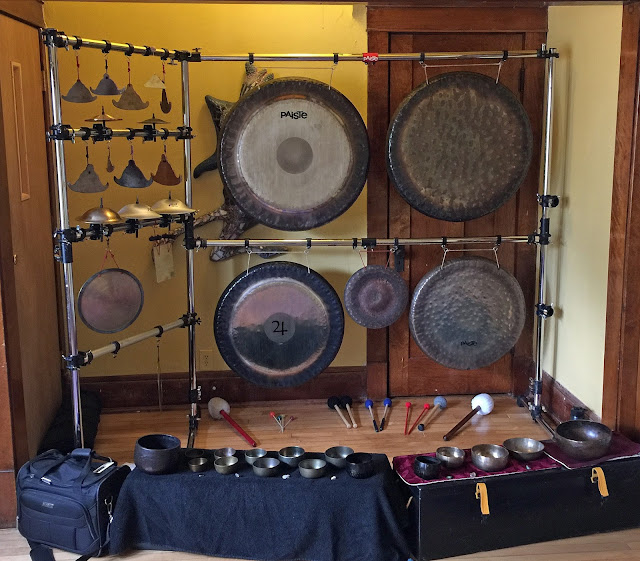The Art of Breathing
If you play trumpet, sax, piano, or even strings, chances are that you were taught to breathe with your phrasing. This then becomes a natural part of your practice and performance. But I have often found that percussionists tend to hold their breath!
There seems to be this sense of extreme concentration, where the breath is held until the musical figures are completed. Then a quick breath, and the process repeats itself. Is it any wonder some music sounds stilted? In order for rhythm to sound flowing and continual, it needs to breathe.
This is especially true of playing long lasting sounds, like Gongs, bowls, and bells. It's important to find the breathing rhythm that works with your performance.
EXERCISE #1:
Take a breath. Then start by striking your Gong/bowl/bell and breathing out at the same time. Feel your breath move out with the sound. Notice how as the sound fades, so does your breath. When both breath and sound have faded enough, take another breath in and repeat the process. Repeat this over and over, feeling/learning how your breath, and the sound, can work together.
EXERCISE #2:
Start as in #1, only halfway through letting the breath and sound out, strike a second Gong/bell/bowl, following that to the end, then inhaling and repeating.
EXERCISE #3:
Repeat as above, only this time play 3 sounds, spaced equally apart. We want to start beathing through a musical phrase.
Here is one way to do these exercises:
You can vary this by the count, for example, count to 12, 14, 20, etc. This may also vary by the instrument, as a 32" Gong would have a longer sustain than a 3" Drilbu Bell.
Also vary this by playing different instruments, for example: strike a large Gong, then a medium bowl, then a small bell, etc.
The idea here is not only to learn how to breathe and connect to the sounds and musical phrases you are playing, but to learn the length of sustain (and thus breath) of each instrument you own. This will help you to play in a more fluid and natural manner.
~ MB
There seems to be this sense of extreme concentration, where the breath is held until the musical figures are completed. Then a quick breath, and the process repeats itself. Is it any wonder some music sounds stilted? In order for rhythm to sound flowing and continual, it needs to breathe.
This is especially true of playing long lasting sounds, like Gongs, bowls, and bells. It's important to find the breathing rhythm that works with your performance.
EXERCISE #1:
Take a breath. Then start by striking your Gong/bowl/bell and breathing out at the same time. Feel your breath move out with the sound. Notice how as the sound fades, so does your breath. When both breath and sound have faded enough, take another breath in and repeat the process. Repeat this over and over, feeling/learning how your breath, and the sound, can work together.
EXERCISE #2:
Start as in #1, only halfway through letting the breath and sound out, strike a second Gong/bell/bowl, following that to the end, then inhaling and repeating.
EXERCISE #3:
Repeat as above, only this time play 3 sounds, spaced equally apart. We want to start beathing through a musical phrase.
Here is one way to do these exercises:
Strike and let out your breath, slowly counting to yourself:
1 2 3 4 5 6 7 8.
Breath in, counting:
1 2 3 4 5 6 7 8.
Repeat.
You can vary this by the count, for example, count to 12, 14, 20, etc. This may also vary by the instrument, as a 32" Gong would have a longer sustain than a 3" Drilbu Bell.
Also vary this by playing different instruments, for example: strike a large Gong, then a medium bowl, then a small bell, etc.
The idea here is not only to learn how to breathe and connect to the sounds and musical phrases you are playing, but to learn the length of sustain (and thus breath) of each instrument you own. This will help you to play in a more fluid and natural manner.
~ MB
Chop Wood / Carry Water / Play Gongs™




Comments
Post a Comment